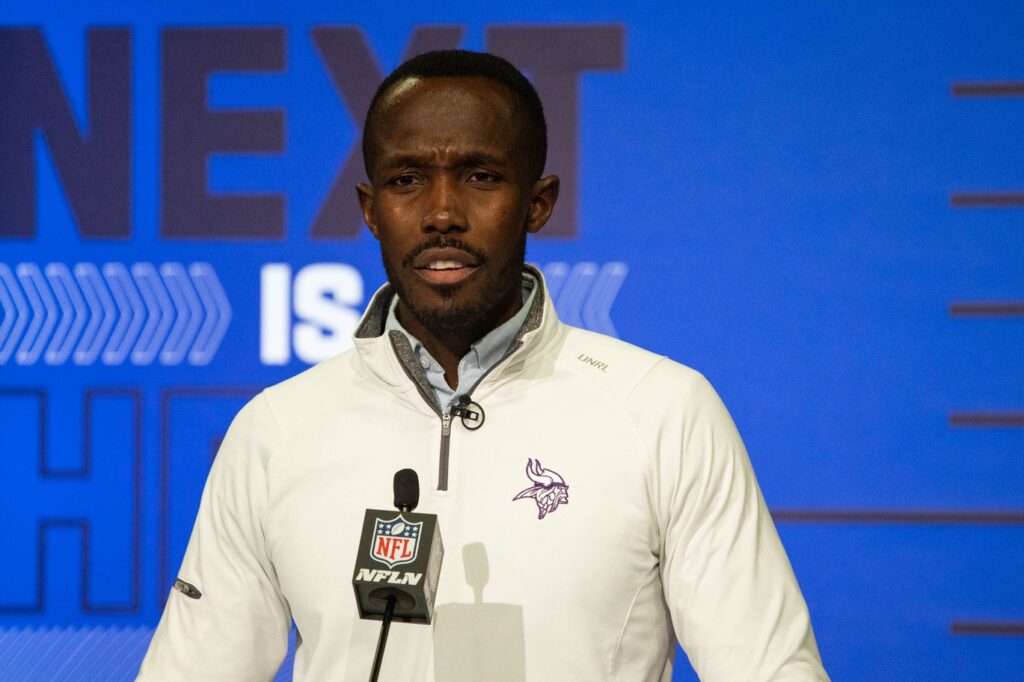Every year when the NFL Draft wraps up, we see it pointed out that a draft class can’t be judged for at least a few years. That certainly passes the common sense test considering how often post-draft analysis misses the mark — just ask Jalen Hurts and Russell Wilson — but it’s also impossible to sit around and wait for three years before forming an opinion. It’s like that with the Minnesota Vikings’ front office at the moment.
With two offseasons under Kwesi Adofo-Mensah’s belt we have a sample size of two very different approaches. Following his hire early in 2022, the Vikings’ GM aimed to stock up the roster with the goal of winning the division and returning to the playoffs after back-to-back seasons of the team watching the postseason from their couches. The Vikings accomplished that goal in part because they found ways, sometimes at the detriment of their salary cap future, to keep their best veteran players on the roster like Adam Thielen and Patrick Peterson and added star pass rusher Za’Darius Smith. The deadline was handled perfectly with the acquisition of an instant-impact star TJ Hockenson in a season where they were in position to go for broke.
It’s fair to question the true strength of the 2022 team when eight fourth-quarter comebacks were required to win 13 games and they were outscored by their opponents but Jimmy Johnson had a point in saying, “you are what your record says you are.” For the purposes of chasing an NFC North, the front office was able to put together a team that was capable of doing it and hired a coach who proved capable of getting them into the postseason and into the top 10 offensively.
The 2022 draft is tricky to evaluate at the present juncture. Rookie seasons aren’t always predictive of how a draft will turn out — just ask Christian Darrisaw, whose Year 2 jump was remarkable. However, some of the decisions did open the door for first-guess criticism. How far the Vikings traded down, what they got in return, the positions they selected, their picks versus the consensus and the concerning injury history of a second-rounder. If it goes sideways, we will be able to look back and say they should have seen it coming. But we can’t make that jump yet. Everyone from the ‘22 draft class deserves another year before wagging any fingers about positional value and drafting for immediate need.
What you want from decision makers is for their choices to fit with the reality of the situation. Moves should appear to be thematic with the team’s timeline and constructed with purpose. We shouldn’t have to guess whether they have a plan or not, it should be obvious by the choices they make. It’s easier to present of examples of that not happening in the recent past like the Vikings extending Kyle Rudolph or trading a second-rounded for Yannick Ngakoue. The Vikings avoided such puzzling decisions this time around.
It took a while but when the dust settled after this year’s minicamp, the roster had been stripped of nearly all of its older, expensive players. Usually it takes a good-luck 13-win team seeing regression the following season before they start building for the future again. This regime elected to start aiming for tomorrow today rather than seeing it crash and burn first. We can pick apart elements of how that got done, whether it’s Kirk Cousins’s restructure or how long they took to make a call on Dalvin Cook or the return for Za’Darius Smith, but the bigger picture equates to a rare and smart decision to throw the youth movement into the fire and figure out who’s who in the zoo for the future.
We can’t just cruise over the Cousins restructure though. Was it a miscalculation? Did they think they were going to extend him? Are they still going to extend him? It doesn’t seem advantageous to take a salary cap roundhouse kick to the face next season, particularly if the motivation was waiting to see if they could get something in a Cook trade rather than moving him to get under the cap. If Cousins exits after this year, the restructure doesn’t destroy the Vikings’ long-term cap, it just makes things a little trickier to add to the roster. If they walk out of 2023 looking like a team on the rise and still can’t spend as much next year because of the handling of his restructure, there will be regrets. And if they extend him before the start of the season, which is still possible despite what Cousins said about talking contract next March, then the entire theme of this offseason will be blown into bits.
Now about the draft. Despite the lack of capital, this year’s felt more like what we can expect from Adofo-Mensah going forward. They picked players at premium positions who graded well by PFF and largely had impressive underlying numbers. None of the moves reeked of desperation to fill an immediate need and they didn’t trade down when their guy was on the board in the first round.
The problem with trying to grade this offseason is that there are still major decisions lingering. Not just kinda/sorta/maybe/nobiggie decisions. Huge, future-shaping things that are still hanging up in the air. Danielle Hunter is holding out. Justin Jefferson did a mini holdout-ish type thing during OTAs and TJ Hockenson doesn’t have an extension in hand.
If Jefferson and Hockenson aren’t signed by Week 1 and the Vikings either made Hunter the highest paid defensive player in the league or traded him for a third-round pick things will feel way different than if they have extensions in place for WR1 and TE1 and either got a reasonable contract for Hunter or dealt him for a first. Much hinges on what’s next in terms of answering the question: Do they know what they’re doing?
The outcomes of those moves still won’t make grading the front office totally easy. What happens next at quarterback and whether it works is going to most influence how this era is defined. A lot can go wrong and be forgiven if that position goes right.
That brings us to the “when” part of the question about evaluating decision makers. It isn’t today. It isn’t this September 1 or next January 1. We should truly have a complete picture of where this ship is headed by the 2025 season. And even then there can be nuance to that discussion because of the quarterback. If bad luck should befall this franchise at QB — not that it would ever happen in Minnesota, right? — we’re going to have to decide whether the totality of all the other decisions are enough to have trust in them building a roster that’s ready for The One at quarterback to win with.
Judging a front office is like predicting the weather. What we think we know can change quickly. The path that the Vikings have taken so far hasn’t been perfect but it has promise. Grading it would be like saying it’s been a good weather summer after the first week of July. That’s about the best we can do right now. When it’s time to say for sure whether it’s worked or not, we’ll probably just know.









